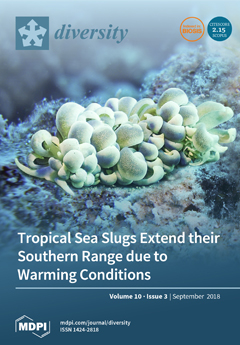In this study, the organelle genomes of
Polytrichum juniperinum Hedw. and
Polytrichum strictum Menzies ex Brid. (Polytrichaceae, Bryophyta) from Antarctica were sequenced and compared with the plastomes of the model moss species
Physcomitrella patens Brid. The sizes of the cpDNA in
P. juniperinum
[...] Read more.
In this study, the organelle genomes of
Polytrichum juniperinum Hedw. and
Polytrichum strictum Menzies ex Brid. (Polytrichaceae, Bryophyta) from Antarctica were sequenced and compared with the plastomes of the model moss species
Physcomitrella patens Brid. The sizes of the cpDNA in
P. juniperinum and
P. strictum were estimated to be 55,168 and 20,183 bp, respectively; the sizes of the mtDNA were 88,021 and 58,896 bp, respectively. The genomes are very similar to each other, with the possible loss of petN in the cpDNA, which also showed some gene inversions when compared with the cpDNAs of
P. patens Brid. In the mtDNA, it is possible that rps10 was lost. In contrast, Antarctic Polytrichaceae species have nad7 and orf187, without the occurrence of rearrangement events. Phylogenomic analyses of the plastid and mitochondria revealed that the majority-rule tree suggests some differences in the plastids ancestry, however,
P. juniperinum and
P. strictum were grouped in the same clade in chloroplast, but in mitochondria
P. strictum was grouped with
Atrichum angustatum (Brid.) Bruch & Schimp. This study helped us understand the evolution of plastomes and chondriosomes in the family Polytrichaceae, and suggest a hybridization event with relation to the mitochondrial data.
Full article





